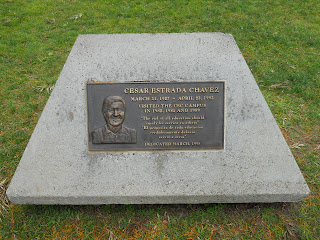 |
| Photo Credit: Fabian S. |
An abstract mural that wraps around all of the interior walls at Casa del Mexicano. Various images depict Chicano history while others depicts suffering in general, such as this image.
 |
| Photo Credit: Fabian S. |
This is an image of the current condition of Casa del Mexicano. It is surrounded by local homes that line up the street leading to the building.
Location: Casa del Mexicano
Address: 2900 Calle Pedro Infante, Los Angeles, 90063
Directions: Take the I-10 E, Take Exit 13a for San Bernardino/Santa Ana, Merge
onto I-10E/Santa Monica Fwy, Take Exit for 4th St, Right on Euclid,
Right on Pedro Infante
Casa del Mexicano, tucked away in a small cul de sac in
Boyle Heights, was once considered a mecca of Mexican culture in Los Angeles. It
was established in 1904 as a Methodist Church which later became a synagogue
and catered to the needs of the large Jewish population that inhabited Boyle
Heights. It wasn’t until 1931 that Casa
del Mexicano came to be. Under the direction of the Mexican Consulate, Casa del
Mexicano became Los Angeles’ first cultural centered catered to the needs of
the Mexican community. In addition to providing services to the surrounding
community and being a place where children could come and learn about Mexican
history in order to familiarize themselves with their roots, Casa del Mexicano
served as the premier location of Mexican culture in Los Angeles for many
years. Dignitaries, actors and other important figures from Mexico and Spain
could congregate in this building to enjoy beauty pageants, cultural exhibits
and theatre displays.
Casa del Mexicano was in essence “a sentinel of Mexican
culture in Los Angeles” which drew everyone to visit it, including the
President of Mexico during its days of glory. During the last few years,
however, the Casa del Mexicano has fallen from what it once was and entered a
period of decay. Renovation efforts have been led under the guidance of the
Comite de Beneficiencia Mexicana, a non-profit organization. These include a
revamping of the center’s programming available to the public, as well as a
renovation of the location itself. One of the center’s most prominent additions
is a mural which covers every inch of the center’s interior which was created
by Teocatl, a Mexican muralist who has made the place his home while he works.
Management
at Casa del Mexicano remains shaky nowadays. Most recently, the center was
placed up for auction after accusations were made against its management.
Advocates of the center’s preservation are seeking investors who will support
the center, but the future of Casa del Mexicano remains unclear for now. (LA
Times)
Submitted by: Ale C., Monica C., Fabian S.
Submitted by: Ale C., Monica C., Fabian S.
Sources
Bermudez, Esmeralda. “Auction of Landmark Casa del Mexicano
is Delayed.” 26 February 2011. LA Times. http://articles.latimes.com/2011/feb/26/local/la-me-casa-del-mexicano-20110226
Bermudez, Esmeralda. “A Boyle Heights cultural landmark has
a vivid past and an iffy future.” 15 February 2011. LA Times. http://articles.latimes.com/2011/feb/15/local/la-me-casa-del-mexicano-20110215
Bermudez, Esmeralda. “New Life for an Old Gem in Boyle
Heights.” 31 July 2008. LA Times. http://www.latimes.com/news/local/la-me-casa31-2008jul31,0,4789711.story
























